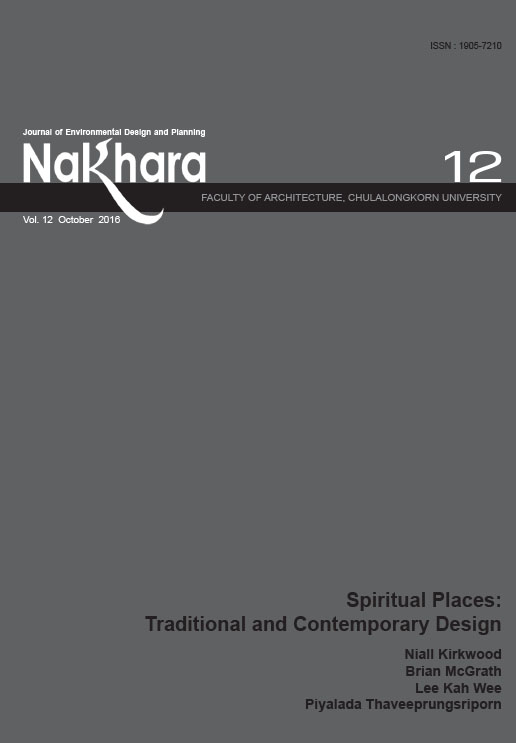Modeling Design and Management of Residential Community for Enhancing Elderly Well-Being in Thai Cultural and Spiritual Environments
Main Article Content
Abstract
This research presents factors related to the environmental perceptions, the residential community, and the design of spiritual and healing environments, which effect the elderly Thai population. The research revealed that their needs were identified as 1) the requirements of general facilities and activities, 2) requirements of facilities related to health and security, and 3) the requirements of facilities related to physical exercise. The results show that the characteristics of the elderly have a direct effect on a variety of requirements needed in the residential community. From observing and interviewing three case studies, the concept of the spiritual environment was necessary for the elderly Thais. The result led to formulating appropriate policies in design and management of the residential community to enhance the quality of life, both physically and mentally, of elderly Thais.
Article Details
References
Barrera-Hernandez, L. F., & Corral-Verdugo, V., & Tapia-Fonllem, C. O., & Fraijo-Sing, B. S. (2015). Psychological meanings of “positive spiritual environment” and “place to communicate with God, " European Scientific Journal, 11(26), 357-369.
Byrne, B. M. (2010). Structural Equation Modeling with AMOS, basic concepts, applications, and programming. New York: Routledge Taylor & Francis Group.
Cambridge Dictionary. (2016). Meaning of “spiritual home” in the English Dictionary. Retrieved from http://dictionary.cambridge.org/dictionary/english/spiritual-home.
Gaskamp, C., Sutter, R., & Mervigilia, M. (2006). Evidence-based guideline promoting spirituality in the older adult. Journal of Gerontological Nursing, 32(11), 8-13.
Jonas, W. B., & Chez, R. A. (2004). Toward optimal healing environments in health care. The Journal of Alternative and Complementary Medicine, 10, Supplement 1, S-1–S-6
Meraviglia, M. (1999). Critical analysis of spirituality and its empirical indicators: Prayer and meaning in Life. Journal of Holistic Nursing, 17(1),18-33.
Nelson, C., West, T., & Goodman, C. (2005). The hospital built environment: what role might funders of health services research play? Rockville, MD: Agency for Healthcare Research and Quality.
Nunnally, J. C. (1978). Psychometric theory (2n ed.). New York: McGraw-Hill.
Paul, J., Nadarajah, Y., Karen, H., & Victoria, S. (2012). Sustainable communities, sustainable development: Other paths for Papua New Guinea. Honolulu: University of Hawaii Press.
Perkins, B., Hoglund, J. D., King, D., & Cohen, E. (2004). Building type basics for senior living. New Jersey: John Wiley & Sons.
Plunz, R. (1982). Design and the public good. Cambridge: MIT Press.
Suchada, T., & Sawalai, B. (2010). Value of elderly from the eyes of Thai society (1st ed.). Nakhonpathom: Institute for Population and Social Research, Mahidol University.
Tabachnik, B. G., & Fidel, L. S. (2001). Using multivariate statistics, (4th ed.) MA: Allyn & Bacon.
The National Committee on the Elderly. the Ministry of Social Development and Human Security Thailand. (2009). the 2nd national plan on the elderly (2002-2021). Bangkok: The Ministry of Social Development and Human Security Thailand.
The Thailand Nation Elderly Committee. (2012). The yearly report of Thai elderly situation 2012. Bangkok: The Ministry of Social Development and Human Security Thailand.
WHO Regional Office for Europe. (2008). Policies and practices for mental health in Europe. Copenhagen: WHO Regional Office for Europe.
World Health Organization. (1946). Constitution of the World Health Organization. Geneva: WHO.
World Health Organization. (2015, December 18). Definition of an older or elderly person. Retrieved from http://www. who.int/healthinfo/survey/ageingdefnolder/en/
Xiong, B., Skitmore, M., & Xia, B. (2015). A critical review of structural equation modeling applications in construction research. Automation in Construction, 49 (2015), 59-70.

